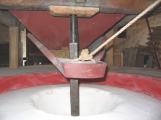20
Sharpening or ?picking? the millstonesThis work, which consisted of making the surface of the millstones rough, was conducted once or twice each year, and usually lasted two weeks. First, the miller had to take off the skirt, or the wooden cage covering the millstones. Then, with the help of the millstone crane, he raised the millstone from above and balanced it in such a way that he could work on the inside surface. With a guard covered in ocre powder, he traced on the rock, as a guide, the places that needed sharpening. Once that work was finished, he used his mechanical coal pick to hammer the millstone and make the necessary cuts on it. The small grooves allowed the grain to make its way between the rocks to be crushed into flour, which was expulsed toward the outside by centrifugal force. This work had to be carried out on each of the inside surfaces of the millstones.












